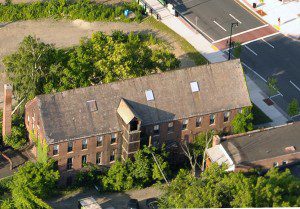
The large brick and mortar building next to the southbound Great River Bridge is the home to the Westfield Whip Mfg. Co. Inc. The company was established in 1884 and is located at 360 Elm Street. (Photo by chief photographer Frederick Gore)
WESTFIELD – The Community Preservation Committee voted last night to accept a feasibility study to create a living museum to preserve the city’s historical industrial past, clearing the way for the next step in developing the museum proposal.
The museum concept was initiated to create a living museum at 360 Elm Street, the city’s last whip manufacturer, but has since expanded to include the diverse industrial past of Westfield.
The CPC had awarded $72,500 in 2010 to Westfield Historical Industries Preservation Project (WHIPP), Inc. for the feasibility study to develop a business plan and assess the viability of establishing the museum.
The WHIPP proponents had consulted with a number of museums in the region, including the Springfield Museums, which recently went through a similar feasibility process. The lessons learned by those other facilities include advertising, monitoring attendance and assessing target audiences, as well as identifying state and federal funding available.
WHIPP hired Bill Hosley, a principal with the Terra Firma Northeast consulting firm, to act as the project manager with the lead in developing the feasibility study. Hosley previously served as the chief curator and exhibition developer at the Wadsworth Athenaeum in Hartford and is an expert in heritage tourism.
Carol Martin, whose family owns the Westfield Whip Manufacturing Company located at 360 Elm Street, said last night that WHIPP, Inc. recently merged with Westfield Museum Inc., a group formed to showcase the city’s industrial history, thus expanding the scope of the original living museum concept to include a display area that will be used to other aspects of the city’s industrial past.
The merger of the two 501-C3 organizations was effective as of July 1.
The feasibility study also included an educational component, creating instructional blocks for the city’s school district through field trips to the museum.
“The project has evolved from a fuzzy concept to be a more broad-based and clearly defined project,” Martin said when presenting the final feasibility report to the CPC board.
That report included an engineering assessment perform by Tighe & Bond of the current whip manufacturing structure to determine suitability of creating the museum in the historic building.
Local architect Chris Carey has developed a design of the museum facility within the building.
Martin said the feasibility study also assesses the viability of operating a museum in the neighborhood which has under gone extensive enhancement as part of the Great River Bridge project. One of several parks built as part of the bridge work is directly across the street from the whip manufacturing building.
Martin said the whip plant is in need of additional parking to support the museum concept, but that the city now owns the land around 360 Elm Street and will need to provide additional parking to facilitate the recreational use of the new riverside parks and Riverwalk along the Westfield River Levee.
Martin said the merger with Westfield Museum Inc., creates a non-profit corporation structure “to maximize the chances of success.”
Ownership of the building would be transferred to the non-profit entity and operated through a board of directors. Westfield Whip Manufacturing would be a tenant and continue to manufacture whips as a living museum display.
The cost of totally renovating the building is more than $4 million. Martin said that is a long-term goal of the group. However, the short term goal is “get the doors open’ for the living museum, a project with an estimated cost of about $1 million.
The Westfield Museum Inc., is currently identifying state and federal funding sources to secure that financing.
The fact that the CPC voted to accept the feasibility study moves the project forward and may qualify it for additional Community Preservation Act funding. The museum proponents plan to apply for additional funds at the CPC’s Sept. 27 session to move the project forward.
City residents were asked to impose an additional tax, a referendum question on the Nov. 5, 2002, ballot.
The Community Preservation Act allows the city to collect funds, which are currently matched at a rate of 22 cents on the dollar by the state, to foster preservation of open space, historical buildings and facilities and to increase the stock of affordable housing for low and moderate income residents. City residents approved the 1 percent surtax on property, with the first $100,000 of that evaluation exempt from the surcharge.
The Community Preservation Committee makes recommendations to the municipality’s legislative body, the City Council in Westfield’s case, for the acquisition, creation and preservation of open space; for the acquisition, preservation, rehabilitation and restoration of historic resources; for the acquisition and preservation of land for recreational use; and for the creation, preservation and support of community housing that is acquired or created.
State law pertaining to the Community Preservation Act was modified this past weekend when Governor Deval Patrick signed the 2013 fiscal year appropriation law. The revisions more clearly define how CPA funds can be expended.
In the past the CPA funds could not be used to rehabilitate existing park and playground facilities, limiting the use of those funds creating new facilities on land purchased through CPA funding. The revised law now allows communities to use CPA funds for park and playground renovation.

